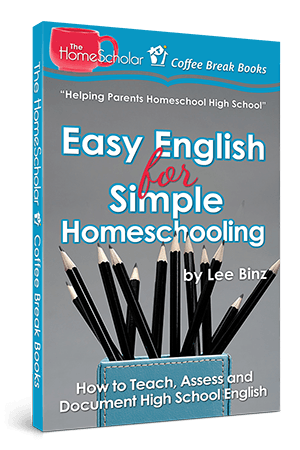~ A word from our founder, The HomeScholar Emeritus, Lee Binz ~
This is a chapter from my book, Easy English for Simple Homeschooling: How to Teach, Assess, and Document High School English. You can purchase a copy in print or Kindle version on Amazon.
Chapter 1
English in Plain English
A high school English class means working on communication skills. That’s what you’re teaching in English — communication. This means writing skills, including spelling, grammar, vocabulary, punctuation, penmanship, composition, reports, poetry, and prose.
English also includes work on reading skills, such as reading for fun, reading literature for school, nonfiction, poetry, parents reading aloud, speed-reading classes, and reading comprehension.
English can also include speaking skills such as public speaking, speech and debate, speaking at church, Toastmasters, or Teen Pact. These experiences can help make students more comfortable when they speak in front of groups.
In high school, not all kids continue with skills workbooks. For example, if they already spell reasonably well, instead of using Spelling Power, All About Spelling, and Sequential Spelling, maybe your child doesn’t need to study spelling at all in high school. Instead of teaching a rigorous grammar curriculum every year, maybe you’ll see that Winston Grammar is all your child needs. Your approach to vocabulary development may also change. You can use games and activities. See my article, SAT Vocabulary – Improve Your Skills the Fun Way! at HomeHighSchoolHelp.com for some ideas. In addition, the card games Rummy Roots and More Rummy Roots can help build vocabulary skills.
Focus on what is important: reading and writing. There are many ways to get there, not everything needs to be covered by all children, and there are many paths to get where you need to go. So, relax!
What is Required?
When people talk about what’s required for courses, it can be confusing, because there are two different kinds of requirements. There are high school graduation requirements (what your child needs to graduate), and there are college admission requirements (what your child needs to get into college).
For English, this is not an issue, because whether your goal is college admission or high school graduation, the requirements are the same. You simply need to provide four years of English during high school.
Provide one credit each year of high school. Teach your student reading at their level and writing at their level. By level, I mean ability level, not grade level.
How Much Each Year?
Usually one credit of English per year is all your child needs, all that is required, and all that I suggest. English is one credit, unless you happen to use two complete English programs, as written, in which case each English program is one credit. However, I usually don’t recommend more than one.
I think it’s always best to avoid overwork and not double up. When you double up in a subject area, it can cause burn out, not only for children, but also for parents. It’s hard to keep up with.
If English is the subject your child struggles with, doing too much can cause even more burn out. It can kill the love of learning, and make your child feel stupid and incompetent, so they end up getting worse as a result.
If it’s their weak area, I recommend keeping English to one credit per year. Don’t try to get them up to grade level within one year of school, especially if it means two or three levels, because this can backfire. If it is their weak area, working on one credit per year is especially important.
The only exception to the one-credit-per-year guideline is if your child has special interests and wants to study more. When we homeschooled, my children loved reading. We planned out our curriculum with Sonlight, which includes writing and tons of reading. It is a pre-measured curriculum and English is one credit each year.
But my children also wanted to write a novel! They saw Learn to Write the Novel Way and wanted to use it. We worked on both Sonlight and the novel curriculum in one year. Honestly, this is one of the reasons I don’t recommend it, because I thought I was going to die! It was the hardest year, ever! I think the only reason any of us survived at all is because the desire to do both courses came from my children.
For most kids, one credit of English per year is perfectly fine. Unless your child’s interest is driving more than one (and even then, be careful), don’t overload your child with more than one English curriculum per year.
Easy English for Simple Homeschooling is one of my Coffee Break Books. What are Coffee Break Books? These are books designed for YOU – a busy homeschool parent feeling frustrated by something, and needing information NOW – all put together in an easy-to-read, short, simple format. Coffee Break Books are perfect for overwhelmed, sleep-deprived moms with a baby on their hip. Simple, large font makes them easy to read even when distracted or pulled in a million directions. They are designed to help parents tackle just ONE issue of homeschooling during just ONE coffee break! Each book combines a practical and friendly approach with detailed, easy-to-digest information. Never overwhelming, always accessible and manageable, each book in the series will give you the tools you need to tackle the tasks of homeschooling high school, one warm sip at a time.
Learn more about Easy English for Simple Homeschooling in my video review below!
This is a chapter from my book, Easy English for Simple Homeschooling: How to Teach, Assess, and Document High School English. You can purchase a copy in print or Kindle version on Amazon.





